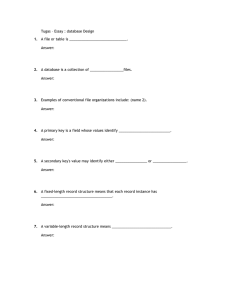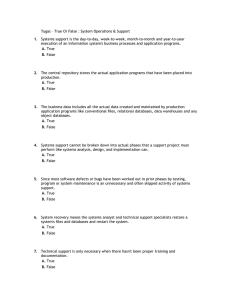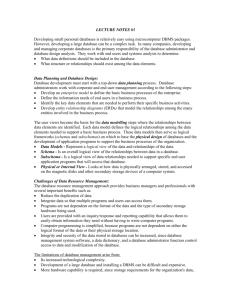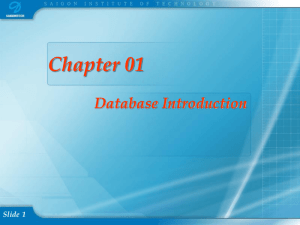1. A. B.
advertisement
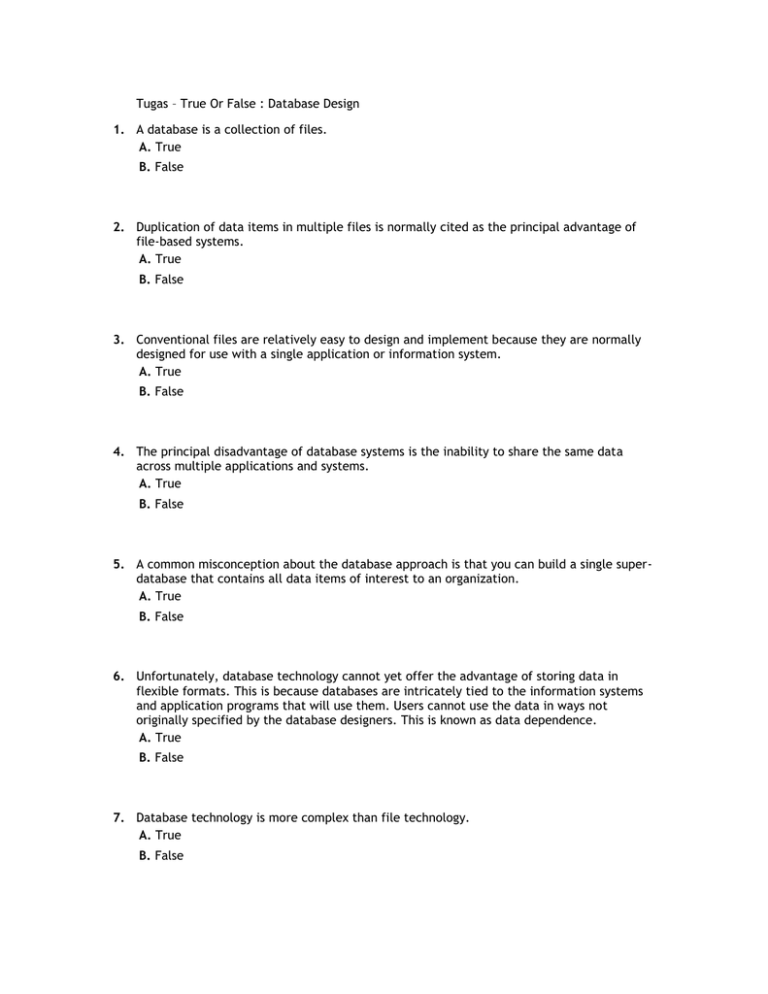
Tugas – True Or False : Database Design 1. A database is a collection of files. A. True B. False 2. Duplication of data items in multiple files is normally cited as the principal advantage of file-based systems. A. True B. False 3. Conventional files are relatively easy to design and implement because they are normally designed for use with a single application or information system. A. True B. False 4. The principal disadvantage of database systems is the inability to share the same data across multiple applications and systems. A. True B. False 5. A common misconception about the database approach is that you can build a single superdatabase that contains all data items of interest to an organization. A. True B. False 6. Unfortunately, database technology cannot yet offer the advantage of storing data in flexible formats. This is because databases are intricately tied to the information systems and application programs that will use them. Users cannot use the data in ways not originally specified by the database designers. This is known as data dependence. A. True B. False 7. Database technology is more complex than file technology. A. True B. False 8. A record is the physical implementation of a data attribute. Records are the smallest unit of meaningful data to be stored in a file or database. A. True B. False 9. A secondary key is a field whose values identify the second record in a file. A. True B. False 10. A foreign key is an alternate identifier for a file. Its value may identify either a single file or a subset of all files. A. True B. False 11. A secondary key might be created by combining the first and second fields. In this situation, it is called a combination key. A. True B. False 12. A single file in a database may only have one foreign key, but it may have several primary keys. To facilitate searching and sorting, a key sequence field is frequently created for keys. A. True B. False 13. Concatenated keys are pointers to the records of a different file in a database and how the database links the records of one type to those of another type. A. True B. False 14. A blocking factor is the number of logical records included in a single read or write operation (from the computer's perspective). A block is sometimes called a physical record. A. True B. False 15. A table is the relational database equivalent of a file. A. True B. False 16. Archival files or tables contain records that describe business events. The data describing these events have an unlimited useful lifetime, and can be archived off-line. A. True B. False 17. Table look-up files are special records of updates to other files, especially master and transaction files. They are used in conjunction with archival files to sort data. Archival dictionaries are typically built into better database technologies. A. True B. False 18. To determine database requirements, a database administrator (DBA) models the system's data requirements as entities and relationships. The entities and relationships provide for the technical implementation of the database. A. True B. False 19. The database is built around the information systems to give both executives and data administrators flexible access to data. A. True B. False 20. Operational databases and transactional databases are synonyms that refer to databases that are developed to support day-to-day operations and business transaction processing for major information systems. A. True B. False 21. Fourth-generation programming languages, query tools, and decision support tools are used to generate reports and analyses off of data warehouses. This is also called data mining. A. True B. False 22. Programmers and database designers purposely create personal and work group databases to be extremely limited. These types of databases cannot contain unique data, or import data from conventional files, operational databases, and/or data warehouses. This saves on user training and maintenance costs. A. True B. False 23. Database administrators (DBAs) are responsible for the data planning, definition, architecture, and management of databases. A. True B. False 24. One or more data administrators are responsible for the database technology, database design and construction consultation, security, backup and recovery, and performance tuning. A. True B. False 25. Database management system (DBMS) refers to the database technology including the database engine, database utilities, database CASE tools for analysis and design, and database application development tools. A. True B. False 26. Database architecture refers to the specialized computer software available from computer vendors that is used to create, access, control, and manage the database. A. True B. False 27. The DDL and database engine hide details concerning how records are organized and allocated to the disk. A. True B. False 28. Multidimensional databases implement data in a series of three-dimensional tables that are linked to one another via primary keys. Each row (sometimes called a relation) consists of named tables (which are fields or attributes) and any number of unnamed columns (which correspond to records). A. True B. False 29. SQL is a DBMS that supports complete database creation, maintenance and usage, and can hide details concerning how records are organized and allocated to the disk. A. True B. False 30. Triggering is a three-step technique that places the data model into first, second and third normal forms. A. True B. False 31. Database design can proceed even if the underlying physical data model is only in second normal form (2NF). A. True B. False 32. In a database, key integrity means that tables can have the same primary key values across records. A. True B. False 33. The foreign key for a record must be allowed to have a NULL value. A. True B. False 34. Key integrity means that appropriate controls must be designed to ensure that no field takes on a value that is outside the range of legal values. A. True B. False 35. Referential integrity means that a primary key cannot take on the NULL value. A. True B. False 36. Domain integrity means that the architecture of relational databases implements the relationships between the records in tables via foreign keys. A. True B. False 37. Centralization analysis of a database establishes which business locations need access to which logical data entities and attributes. A. True B. False 38. Distributed data analysis establishes that a database would be implemented on a single server regardless of the number of physical locations that may require access to it. A. True B. False 39. Horizontal distribution of the data means that each table or entire rows in a table would be assigned to different database servers and locations. A. True B. False 40. Horizontal distribution of the data results in efficient access and security of data because each location has only those tables and rows required for that location. A. True B. False 41. Vertical distribution of the data means that each table or entire rows in a table would be assigned to different database servers and locations. A. True B. False 42. Most modern data definition languages (DDL) include powerful, menu-driven database generators that automatically create a DBMS and generate a prototype database from that DBMS. A. True B. False 43. It is important for the data definition language (DDL) to estimate how much disk capacity is required for a new database to ensure that sufficient disk space is available. A. True B. False
